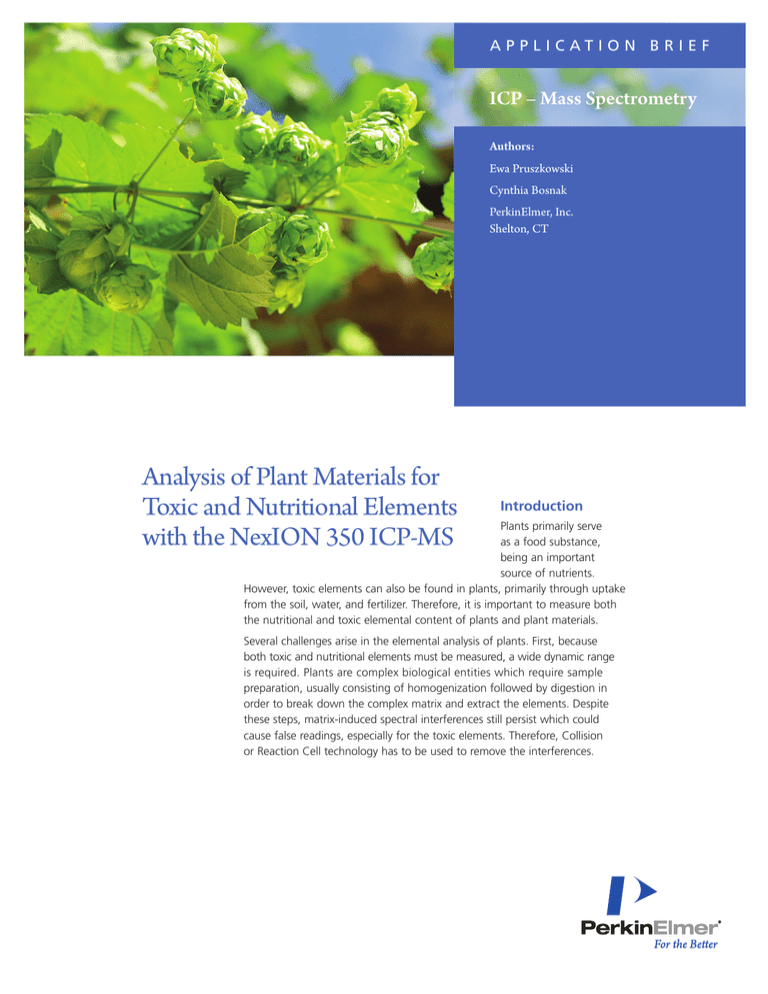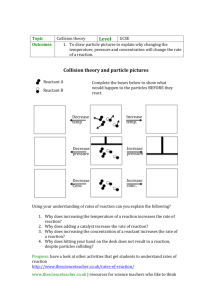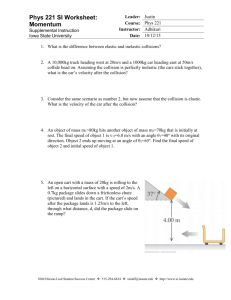
A P P L I C AT I O N B R I E F
ICP – Mass Spectrometry
Authors:
Ewa Pruszkowski
Cynthia Bosnak
PerkinElmer, Inc.
Shelton, CT
Analysis of Plant Materials for
Toxic and Nutritional Elements
with the NexION 350 ICP-MS
Introduction
Plants primarily serve
as a food substance,
being an important
source of nutrients.
However, toxic elements can also be found in plants, primarily through uptake
from the soil, water, and fertilizer. Therefore, it is important to measure both
the nutritional and toxic elemental content of plants and plant materials.
Several challenges arise in the elemental analysis of plants. First, because
both toxic and nutritional elements must be measured, a wide dynamic range
is required. Plants are complex biological entities which require sample
preparation, usually consisting of homogenization followed by digestion in
order to break down the complex matrix and extract the elements. Despite
these steps, matrix-induced spectral interferences still persist which could
cause false readings, especially for the toxic elements. Therefore, Collision
or Reaction Cell technology has to be used to remove the interferences.
One plant species which is gaining considerable interest in the
U.S. is cannabis (i.e. marijuana) since its use has been legalized in
several states, both for recreational and medicinal purposes
through inhalation and consumption in food products. With its
increased use, interest in the toxic and mineral element content
has also risen.
An additional challenge of cannabis analysis in the U.S. is legally
attaining samples, since it is illegal in some states. However, hops
are a generally accepted surrogate for cannabis due to its similar
chemical and physical properties.
This work discusses the analysis of hops (as a surrogate for
cannabis) for both toxic and nutritional elements with ICP-MS.
Experimental
Sample Preparation
Hops were purchased from a commercial store and chopped into
small pieces, both to homogenize the sample and expose more
surface area for increased digestion efficiency. The Titan MPS™
microwave sample preparation system with the standard 75 mL
PTFE vessels was used for digestion, following the program in
Table 1. Each vessel contained 0.25 g of plant material, 5.0 mL
of concentrated nitric acid, 5.0 mL water, and 3.0 mL of 30%
hydrogen peroxide. After digestion, the samples were diluted to
50 mL with deionized water, along with the addition of gold (Au)
to stabilize mercury (200 µg/L Au in the final solution).
Table 1. Titan MPS Microwave Digestion Program
Step
Target Temp Pressure, Ramp Time Hold Time Power
(°C)
Max (bar)
(min)
(min)
1
150
30
5
5
60
2
200
30
5
20
90
3
50
30
1
10
0
Instrumental Conditions
All analyses were performed on a PerkinElmer NexION® 350
ICP-MS with the standard sample introduction components and
conditions. The elements and analysis mode used are shown in
Table 2. The internal standards were added on-line via a mixing
tee. The final concentration introduced to the instrument were
10 mg/L Sc, 5 mg/L Ge, and 0.1 mg/L Rh, In, Tb in 10% methanol
and 1% nitric acid. Using both Standard and Collision modes, the
analysis time was 100 seconds per sample.
Results and Discussion
Table 3 shows the average results for two digestions of hops.
To test the accuracy, pre-digestion spikes were added for those
elements present at less than 50 mg/kg. The spike levels were
20 mg/L for all elements, except Hg, which was spiked at 2 mg/L.
All spike recoveries were within 15% of the added amounts,
further validating the methodology.
2
Table 2. Elements and Analysis Mode
Element
Beryllium (Be)
Boron (B)
Sodium (Na)
Magnesium (Mg)
Aluminum (Al)
Phosphorus (P)
Sulfur (S)
Potassium (K)
Calcium (Ca)
Vanadium (V)
Chromium (Cr)
Manganese (Mn)
Iron (Fe)
Cobalt (Co)
Nickel (Ni)
Copper (Cu)
Zinc (Zn)
Arsenic (As)
Selenium (Se)
Strontium (Sr)
Molybdenum (Mo)
Cadmium (Cd)
Tin (Sn)
Antimony (Sb)
Barium (Ba)
Mercury (Hg)
Thallium (Tl)
Lead (Pb)
Thorium (Th)
Uranium (U)
Mass
9
11
23
24
27
31
34
39
44
51
52
55
56
59
60
63
66
75
78
88
95
111
118
121
137
202
205
208
232
238
Mode
Standard
Standard
Collision
Collision
Collision
Collision
Collision
Collision
Collision
Collision
Collision
Collision
Collision
Collision
Collision
Collision
Collision
Collision
Collision
Collision
Collision
Collision
Standard
Standard
Standard
Standard
Standard
Standard
Standard
Standard
Experimental (mg/kg)
0.00
27.7
13.2
3617
10.8
6580
2001
34358
10936
0.04
0.23
17.3
58.6
1.33
2.27
6.27
31.8
0.03
0.20
17.9
0.93
0.02
0.28
0.01
18.1
0.04
0.00
0.65
0.00
0.00
% Recovery
86
106
113
--108
--------101
96
113
--105
107
90
122
100
102
99
102
97
96
96
94
97
88
87
95
95
Table 3. Results for Analysis of Hops
Element
Be
B
Na
Mg
Al
P
S
K
Ca
V
Cr
Mn
Fe
Co
Ni
Cu
Zn
As
Se
Sr
Mo
Cd
Sn
Sb
Ba
Hg
Tl
Pb
Th
U
Conclusions
References
This work has demonstrated the ability of the NexION 350
ICP-MS, combined with a Titan MPS microwave, to effectively
analyze hops (as a surrogate for cannabis) for both nutritional
and toxic elements. Analyses are accomplished in both Collision
and Standard modes and require only 100 seconds per sample.
The accuracy of the applied method was previously validated by
analyzing a variety of NIST™ plant materials1.
1. Bosnak, C., Pruszkowski, E., “The Determination of Toxic,
Essential, and Nutritional Elements in Food Matrices Using the
NexION 300/350 ICP-MS”, PerkinElmer Application Note.
Consumables Used
Component
Description
Part Number
Sample Uptake Tubing
0.38 mm id (green/orange), PVC, flared, 2-stop
N0777042
Drain Tubing
1.30 mm id (gray, gray), Santoprene, 2-stop
N0777444
Internal Standard Addition Tee
Tee for on-line addition of internal standard
N0777295
Internal Standard Uptake Tubing
0.25 mm id (red/orange), PVC, flared, 2-stop
N0773111
Multielement Standard Solution
100 mg/L Ag, Al, As, Ba, Ve, Ca, Cd, Co, Cr, Cu, Fe, K, Mg, Mn, Mo, Na, Ni, Pb, Sb,
Se, Sn, Sr, Tl, V, Zn
N9301721 (125 mL)
Multielement Salt Solution
1000 mg/L Ca, Mg, Na, K
N9307805 (125 mL)
Mercury Solution
10 mg/L Hg
N9300253 (125 mL)
Internal Standard Solution
Sc (100 mg/L), Ge (50 mg/L), and In, Rh, Tb (1 mg/L)
N9308592 (125 mL)
Pure-Grade Au Standard
1000 mg/L
N9303728 (125 mL)
Autosampler Tubes
Conical, metal-free, sterile
N0776118 (15 mL)
N0776116 (50 mL)
PerkinElmer, Inc.
940 Winter Street
Waltham, MA 02451 USA
P: (800) 762-4000 or
(+1) 203-925-4602
www.perkinelmer.com
For a complete listing of our global offices, visit www.perkinelmer.com/ContactUs
Copyright ©2015, PerkinElmer, Inc. All rights reserved. PerkinElmer® is a registered trademark of PerkinElmer, Inc. All other trademarks are the property of their respective owners.
012267_01PKI




